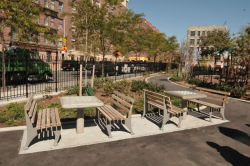Fox Park
View all monuments in NYC Parks, as well as temporary public art installations on our NYC Public Art Map and Guide.
Puerto Rican Sun
| Artist: | Rafael Ferrer |
| Dedicated: | October 16, 1979 |
| Location: | Fox and 156th Streets |
Artwork History
Puerto Rican Sun, a 25-foot-tall, brightly colored painted Cor-Ten steel archway, is by Puerto Rican born artist Rafael Ferrer (b. 1933), and was dedicated at Fox Park on October 16, 1979. The 12,000-pound sculpture, fabricated by Lippincott Inc., represents arching palm trees embracing the sun on its face, and the moon on its back.
The sculpture stands in front of a green and playground created initially as a community garden on a vacant lot after the removal of abandoned housing. As part of this partnership between the city and local residents, and efforts to improve this public space, the Bronx Venture Corporation--a community development organization dedicated to combating “the symbols of distress” and the very real deterioration of the South Bronx-commissioned Ferrer, at a cost of $25,000 to create this sculpture as a focal point. Funding for the project was provided primarily from the Art in Public Places program of the National Endowment for the Arts.
The work was Ferrer’s first large-scale commission in the United States. The Corporation elicited artist recommendations from experts in the field of public art, and ultimately considered the work of six artists: Alice Aycock, Dennis Oppenheim, Christo, Tom Doyle, George Trakas, and Ferrer. In considering their choice of artist, the selection committee sought to select someone who “could speak creatively to [the] needs and aspirations” of the community, and would have “significant insight and understanding into [the] values, life-style, [and] language” of the predominantly Hispanic-American neighborhood.
Ferrer was born in Santurce, Puerto Rico, and was schooled at Catholic schools, before enrolling in 1948 in the Staunton Military Academy in Virginia. In 1951-52 he studied liberal arts at Syracuse University, and enrolled in 1952 at the University of Puerto Rico, where he took a painting course taught by E. F. Grannell, which had a profound influence on him. He also was involved at that time as a drummer in local bands. In 1953 he traveled to Europe where he was exposed to various contemporary trends in art, and by the mid-1950s had settled in New York City, where he dedicated his time to painting and music.
In 1960 Ferrer returned to Puerto Rico where his artistic career blossomed, and his sculpture was exhibited at the Museum of the University of Puerto Rico. Yet feeling constrained, Ferrer relocated to the United States in 1966, settled in Philadelphia, and began teaching at the Philadelphia College of Art in 1967. By the late 1960s Ferrer was exhibiting his work at various galleries in New York and abroad, and was represented for many years by Nancy Hoffman Gallery. He has lectured on art at universities around the United States, and has been on the faculty of the School of the Visual Arts. His works are in numerous private and public collections, and is presently working on commissions in Puerto Rico.
Over time the Puerto Rican Sun suffered from structural corrosion, environmental weathering, graffiti, and paint-overs . In 2003 the Parks Department’s Citywide Monuments Conservation Program, a public-private initiative, conserved and recreated the work’s vibrant, expressionistic painted surface. Layers of paint were removed, and the subsurface metal was stabilized and primed. Consulting with Ferrer, the conservation team repainted the broad gestural strokes that characterized the artist’s original celebratory conception.
Artwork Details
| Description: | Assemblage of upright plates |
| Materials: | Cor-ten steel |
| Dimensions: | H: 22' W: 25'6" D: 22' at base; Weight: 10,000 pounds |
| Fabricator: | Lippincott Inc. |
| Donor: | Bronx Venture Corporation |
| Cast: | 1979 |
Please note, the NAME field includes a primary designation as well as alternate namingsoften in common or popular usage. The DEDICATED field refers to the most recent dedication, most often, butnot necessarily the original dedication date. If the monument did not have a formal dedication, the yearlisted reflects the date of installation.
For more information, please contact Art & Antiquities at (212) 360-8163.
Check out your park's Vital Signs
Clean & Safe
Green & Resilient
Empowered & Engaged Users
Share your feedback or learn more about how this park is part of a
Vital Park System











